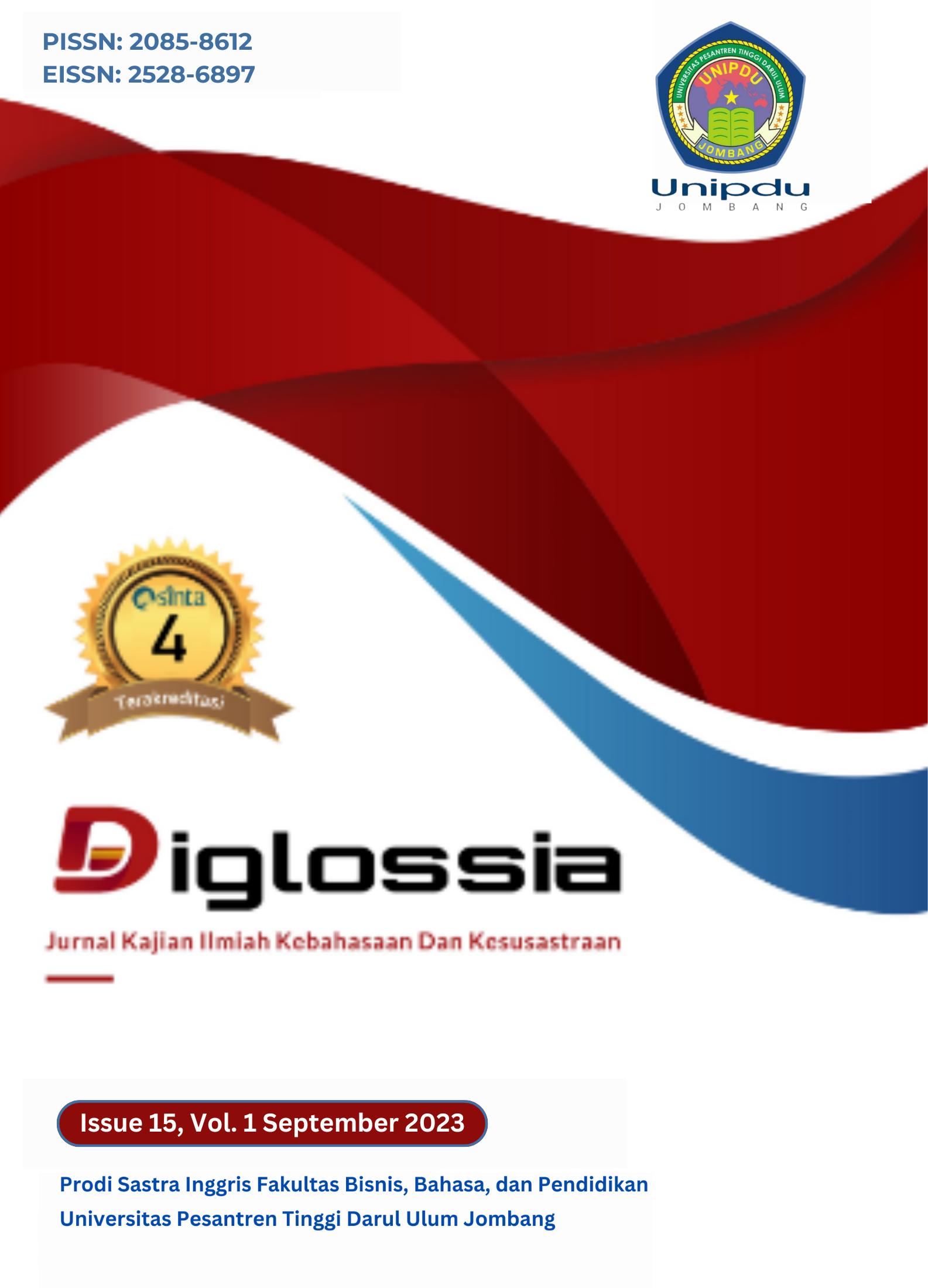Go Green Culture in Selametan Katerbi’en Tradition of Madura
Budaya Go Green dalam Tradisi Selametan Katerbi'en Madura
DOI:
https://doi.org/10.26594/diglossia.v15i1.3424Keywords:
culture, ecolinguistic, ideology, semioticsAbstract
Humans have been preserving nature even before the popularisation of the go-green movement. This research plays a substantial role in confessing natural elements in reducing global warming. This research used a qualitative approach to reveal the correlation between environments and languages. Besides, tradition is not only inherited local wisdom, but in-depth, it consists of wise messages behind. This data analysis through the triangulation of validity data produced eco-lexicons, semiotic interpretations, and the ancestral ideologies of the Madurese community. The discussion identified that the Madurese tradition assimilated with the Javanese tradition in preserving environments viewed from several similarities. It means there is also an ideological resemblance between these both. In the end, knowing the messages inside this tradition will provide a broader understanding of the ancestors' beliefs that humans need to protect nature. This research also suggests the possibility of shared messages between two or more intersecting cultures.
Keywords: culture, semiotics, ideology, ecolinguistics.
References
Ainsworth, J. (2021). An Ecolinguistic Discourse Approach to Teaching Environmental Sustainability: Analyzing Chief Executive Officer Letters to Shareholders. Business and Professional Communication Quarterly, 84(4), 386–408. https://doi.org/tps://doi.org/10.1177/23294906211025498
Akmal, & Widayati, D. (2021). Language and Ecology In Silau Malela Society (Ecolinguistics Study). Lensa: Kajian Kebahasaan, Kesusastraan, dan Budaya, 11(2), 185–193. https://doi.org/10.26714/lensa.11.2.2021.185-193
Coleman, L. J., Bahnan, N., Kelkar, M., & Curry, N. (2011). Walking The Walk?: How The Theory Of Reasoned Action Explains Adult And. The Journal of Applied Business Research, 27(3), 107–116.
Creswell, J. W. (2015). Penelitian Kualitatif dan Desain Riset. Pustaka Pelajar.
Fadhilah, N., Hodairiyah, & Dewi, E. W. (2022). Klasifikasi Warna Dalam Bahasa Madura Dialek Sumenep: Analisis Berlin Dan Kay. SEMIOTIKA: Jurnal Ilmu Sastra dan Linguistik, 23(1), 32–45. https://doi.org/10.19184/semiotika.v23i1.24294
Fauziyah, S., & Sulistyo, W. D. (2021). Nilai-Nilai Pendidikan Karakter Dalam Tradisi Tajinan (Sora Dan Sappar) Masyarakat Kraksaaan, Kabupaten Probolinggo). AL-FIKRU: JURNAL PENDIDIKAN DAN SAINS, 2(2), 245–256.
Fill, A., & Mulhausler, P. (2001). The ecolinguistics reader: language, ecology, and environment. Continuum.
George, L., & Jhonson, M. (1980). Metaphors We Live By. University of Chicago Press.
Hariati, P., Saragih, A., & Husein, R. (2022). Ecolinguistics Studies For Naming ObjectsIn Bukit Lawang Tourism. Journal of Positive School Psychology, 6(8), 9566–9589.
Hartino, A. T., Bhetari, A., Suri, D. R., Octaviani, F., Karerina, N., & Purnianingsih. (2021). Peran Warga Negara Muda Dalam Upaya Pengembangan Konsep Go Green. 1(11), 15–25.
Indriyanto, K. (2021). AN ECOLINGUISTICS ANALYSIS OF THE WIND GOURD OF LA’AMAOMAO. International Journal of Humanity Studies, 5(1), 97–108. https://doi.org/DOI: 10.24071/ijhs.v5i1.3717
Kingsnorth, P., & Hine, D. (2009). The dark mountain project manifest.
L. J. Moleong. (2017). Metode Penelitian Kualitatif (36 ed.). PT. Remaja Rosdakarya Offset.
Lindø, A. V., & Bundsgaard, J. (eds. . (2000). Dialectical ecolinguistics. In 30 Years of Language and Ecology (Nomor December). University of Odense Research Group for Ecology, Language & Ideology.
Luardini, M. A., Asi, N., & Garner, M. (2019). Ecolinguistics of ethno-medicinal plants of the Dayak Ngaju community. Language Sciences, 74, 77–84. https://doi.org/10.1016/j.langsci.2019.04.003
Mbete, A. M. (2003). Bahasa dan Budaya Lokal Minoritas: Asal Muaasal, Ancaman dan Ancaman Pemberdayaan dalam rangka PIP Kebudayaan. Universitas Udayana Bidang Sastra & Budaya, 83.
Midgley, M. (2011). The Myths We Live By. Routledge.
Putri Mulia, F. S., & Fauzi, R. (2021). Kampanye Public Relations “Ngopi tapi Go Green” di RBoJ Coffee. Jurnal Riset Public Relations, 1(1), 39–56. https://doi.org/10.29313/jrpr.v1i1.113
Rusuli, C., Q, F., N., S., & M., H. (2016). The Effectiveness of Go Green Implementation among Society in Kota Bharu, Kelantan. European Journal of Multidisciplinary Studies, 1(1), 7–11. https://doi.org/10.26417/ejms.v1i1.p10-14
Stibbe, A. (2021). Ekolinguistics: Language, Ecology and The Story We Live By (2 ed.). Routledge.
Suhartono, & Mutmainnah. (2019). Perubahan Makna Tanah Warisan Pada Masyarakat Desa Bunder Kecamatan Pademawu Kabupaten Pamekasan. Jurnal Pamator, 12(2), 122–127. https://doi.org/DOI: https://doi.org/10.21107/pamator.v12i2.6286
Yuniawan, T., Rokhman, F., Rustono, & Mardikantoro, H. B. (2017). The Study of Critical Eco-Linguistic in Green Discourse: Prospective Eco-Linguistic Analysis. Humaniora, 29, 291–300. https://doi.org/DOI: 10.22146/jh.v29i3.27441
Downloads
Views: 312 | Downloads: 304
Published
How to Cite
Issue
Section
License
Copyright (c) 2023 Diglossia: Jurnal Kajian Ilmiah Kebahasaan dan Kesusastraan

This work is licensed under a Creative Commons Attribution 4.0 International License.
- Authors who submit a manuscript to this journal and accepted for publication, copyright of the article shall be assigned to the authors of the article.
- Copyright encompasses exclusive rights to reproduce and deliver the article in all forms and media, including reprints, photographs, and any other similar reproductions, as well as translations. The reproduction of any part of this journal, its storage and transmission of databases by any forms or media, such as electronic, mechanical copies, photocopies, and recordings will be allowed by Diglossia
- Editorial Board of Diglossia tries to make every effort to ensure that no wrong or misleading data, opinions or statements be published in the journal. The contents of the articles published to Diglossia are sole and exclusive responsibility of their respective authors.
- The copyright form should be filled with respect to article and be signed originally and sent scanned document file (softcopy) and the article to our email, jurnal.diglossia@fbs.unipdu.ac.id or sent it to the Editorial Office in the form of original hard copy and the article in softcopy form on Flash Disc or Compact Disc, to;Diglossia: Jurnal Kajian Ilmiah Kebahasaan dan Kesusastraan
Prodi Sastra Inggris Fakultas Bisnis dan Bahasa
Universitas Pesantren Tinggi Darul Ulum
Kompleks Pondok Pesantren Darul Ulum
Rejoso Peterongan Jombang Jawa Timur 61481

